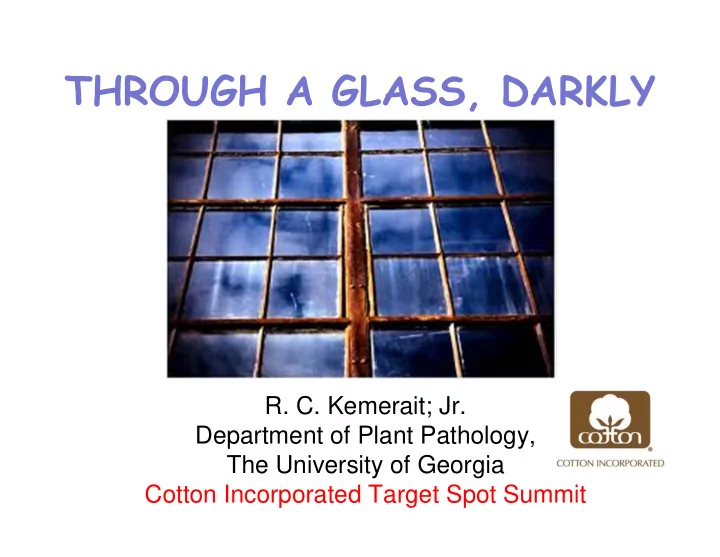

THROUGH A GLASS, DARKLY R. C. Kemerait; Jr. Department of Plant Pathology, The University of Georgia Cotton Incorporated Target Spot Summit
Foliar Diseases of Cotton • Historically considered “incidental” for cotton production in Georgia. • Various causes- – E.g. Cercospora , Stemphylium , Alternaria – Stemphylium leaf spot tied to nutrient deficiencies, esp. potassium • Wet weather blight (Ascochyta blight) Ascochyta wet weather blight – Phoma – Typically seen on younger plants – Rarely seen today Aereolate mildew, Appling Trial 2007 • Aereolate mildew – Ramularia – Sporadic occurrence • Corynespora leaf spot – J.P. Jones 1963 – Southwest Asia- to – Include boll rots
Stemphylium Leaf Spot on Cotton Seminole County 2009 Rome Ethredge
Leaf Spot Disease in Attapulgus Stemphylium leaf spot 8 September 2009
Cercospora Leaf Spot on Cotton Colquitt County 2009
Cercospora Leaf Spot on Cotton Colquitt County 2009
Fungicides for Foliar Diseases of Cotton • Topsin-M – Section 18 in Florida – Specifically for hardlock – May also benefit leaf health • Headline (pyraclostrobin) – Received Section 3 label in 2007 – Single application expected – Labeled for foliar disease control – “Plant Health” benefit? • Quadris (azoxystrobin) – Supplemental label received in July 2008
2007 Appling County Fungicide Trial Photograph by Sandy Newell Untreated Plot/Areolate Mildew
2007 Appling County Fungicide Trial Photograph by Sandy Newell Pyraclostrobin mid-canopy/Areolate Mildew
Appling County Fungicide Trial 2007 1488 1450.7 1449.3 1402.7 1386.7 1500 A A A A A 1250 1000 LINT (lb/A) 750 500 250 0 Untreated Headline, 6.14 fl oz Caramba, 12 fl oz Quadris, 9.2 fl oz Topsin, 16 fl oz
Two shots of Headline (6 fl oz/A) and 0 lb/A vs 180 lb/A potassium Stemphylium leaf spot 2010
Cotton Fungicide Studies 2004 + 2005 Tifton, 2005 + 2006 Attapulgus, 2007 Appling Co. 2 (3) Applications beginning at full bloom Bottom line- 10 times made a little money, 10 times lost money 50 Value ($/A) compared to control 0 TIF 2004 AT 2005 TIF 2005 AT 2006 APP 2007 -50 -100 Headline, 6.14 oz Headline, 9.2 oz Quadris, 6 oz Quadris, 9 oz Topsin , 16 oz Topsin, 16 oz (4)
In desperation, “BOB!! It CAN’T all be potassium deficiency”
Leaf Spot Diseases in Decatur County (likely Corynespora and/or Cercospora ) 8 September 2009
Corynespora cassiicola
2010 Attapulgus REC, Decatur County Stemphylium and Corynespora Leaf Spots (Affected leaves only) Fungicide programs analyzed across cotton varieties August 23 2010 LSD=3.221 9.8 10 %Leaf Area Affected 8 6 4.4 4 3.4 2 0 Headline, 6 fl oz/A Headline, 12 fl oz/A Untreated Fungicide Program
2010 Attapulgus REC, Decatur County Stemphylium and Corynespora Leaf Spots Fungicide programs analyzed across cotton varieties Prob(F)=0.7285 4000 Seed cotton (lb/A) 3440 3413 3500 3348 3000 2500 2000 Headline, 6 fl oz/A Headline, 12 fl oz/A Untreated Fungicide Program
2010 Thomas County Field stripped with/without Headline 6 fl oz/A RJ Byrne
2010 Commercial Grower Trial, Thomas County Corynespora Leaf Spot RJ Byrne, UGA Cooperative Extension P<0.05 100 72 75 % Defoliation 50 25 25 0 Headline, 6 fl oz/A Untreated Fungicide Program
2010 Commercial Grower Trial, Thomas County Corynespora Leaf Spot RJ Byrne, UGA Cooperative Extension P<0.1 1400 1318 1300 Lint (lb/A) 1254 1200 1100 Headline, 6 fl oz/A Untreated Fungicide Program
Through a glass, darkly…… • Stemphylium leaf spot. – Neither disease severity nor defoliation affected by fungicides. – Yield not affected by fungicide applications. – Disease severity and defoliation significantly affected by pre ‐ plant application of potassium but in ‐ season foliar application of potassium. • Corynespora leaf spot disease – Disease severity and defoliation reduced with application of fungicides. – Yields increased with application of fungicides, statistically significant (64 lb/A lint) in one trial. – Best timing….. – Best fungicides…. – Best recommendations……. – Best economics………. – Boll rots……….
Foliar Diseases of Cotton • Historically considered “incidental” for cotton production in Georgia. • Various causes- – E.g. Cercospora , Stemphylium , Alternaria – Stemphylium leaf spot tied to nutrient deficiencies, esp. potassium • Wet weather blight (Ascochyta blight) Ascochyta wet weather blight – Phoma – Typically seen on younger plants – Rarely seen today Aereolate mildew, Appling Trial 2007 • Aereolate mildew – Ramularia – Sporadic occurrence • Corynespora leaf spot – J.P. Jones 1963 – Southwest Asia- to – Include boll rots
Acknowledgements – BASF – Calvin Perry – Billy Mills – Jared walls – Michael Foster – Lina Young – Joy Carter – Jeannette Mixon – Benji Baldree – Jhen Bennett
Recommend
More recommend